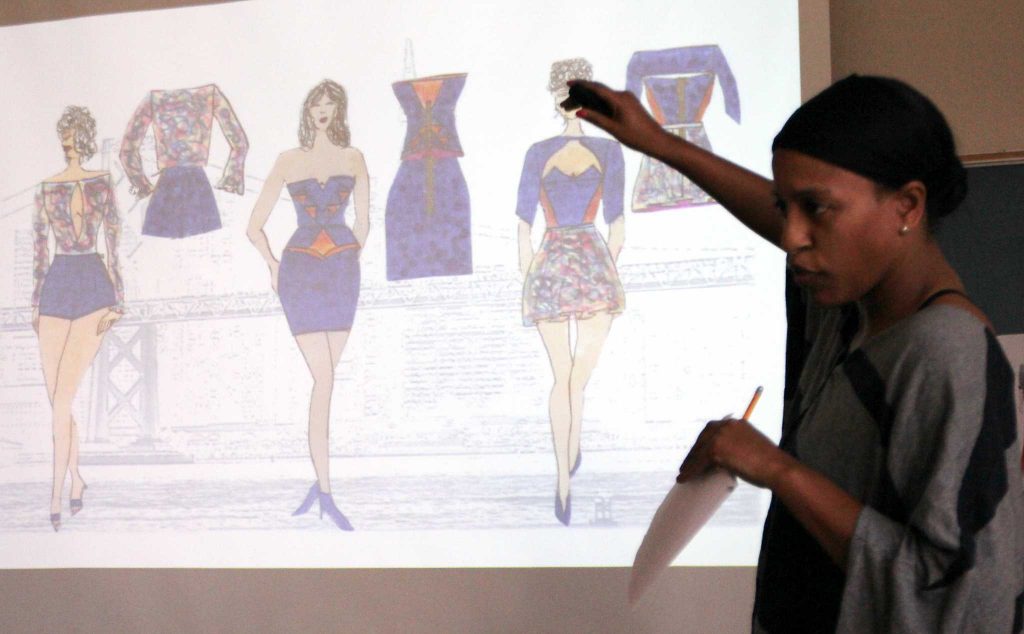On the fourth floor of Burk Hall, scissors are snipping, sewing machines are whirring, and naked, faceless dress forms are looming in the background as senior designers begin to bring their clothing concepts to life. Ruler in hand, apparel design and merchandising student Wei Kong maps out the pattern for a pair of pants. For Kong and her peers, spring semester signifies their final showcase at SF State.
The graduating designers presented their initial concept sketches and mood boards to a panel of judges Feb. 10, an endeavor the department has never undertaken before. The five-person panel, comprised of faculty members from various design departments, scored the presentations in four categories that emphasized unique vision, cohesion and overall professionalism.
Panelists selected eight concepts to be featured in a display in Burk Hall, Room 334, from Feb. 17 through March 2. The winning designers included Maile Driggs, Lia Herrera, Yvonne Ortiz, Sarah Yiu, Alina Bushnell, Christine Ng, Craig Chao and Kong.

“I thought they were great,” panelist Joshua Singer said. “It’s interesting to see the wide range of ideas and wide range of skills. For me, I was looking for the thing that communicated to me at a deeper level. I think there’s a way you can do that visually – you almost don’t have to explain it.”
Students enrolled in the department’s capstone course must construct a minimum of three outfits, said Kelly Reddy-Best, ADM assistant professor. The department encourages graduating students to present their collections at SF State’s spring runway show, which she said will be held April 28 at the San Francisco Design Center.
“This was the final concept stage,” Reddy-Best said. “At this point, they build. It’s always kind of interesting to see what they’re making. They really have the ability to experiment, which is cool, because you don’t necessarily get that much experimentation in the industry.”
Each student’s collection voices a distinctive personal narrative. They all bring their own design aesthetic to the table, according to Reddy-Best.
Kong’s paint-spattered mood boards are a nod to people in her past, she told the panel, equally inspired by those who were kind and those who were cruel. She said she isn’t interested in luxury, and rather is focusing on pieces that are simple and ready-to-wear. Kong’s concept reflects what she calls the “mindset of abundance.”
“My design, it’s not crazy,” Kong said. “It’s always about what I feel for the moment. Mindset of abundance means people should help each other out and truly appreciate each other. I want to do classics with some twists – practical, function and comfort.”

Driggs’ designs celebrate the feminine figure. Influenced by professional women who aren’t afraid to challenge fashion norms, Driggs said her pieces will be flowy, fitted and strategically cut to flatter curves.
“It’s an exciting time for women,” Driggs said. “You can be powerful, you can be a leader, and you can still be sexy and embrace the fact that you’re a female. My collection is very feminine, and a lot of skin will be showing, which I’m really excited about.”
Herrera is among the designers who will be working with unconventional materials. For Herrera, that means glass and plastic, as she aims to create wearable art.
“For every project, my inspiration changes,” Herrera said. “For my collection, I was inspired by mirror and pieces of glass, paper, things that fold. They’re not just avant-garde clothes that you wear once in your lifetime. I want something that would be versatile, you know, so if I make a top that has a weird neck-mirror piece, you can take that off.”
After previewing the design students’ concepts, Singer, who has never attended the ADM fashion show, said he looks forward to seeing the finished pieces on the runway.
“This has definitely sparked my interest,” Singer said. “I’d like to go this year, because I’d like to see how it plays out.”
Reddy-Best said she looks forward to watching the student collections come together over the next two months. She noted that the designers are flying solo now, setting their own schedules and making their own goals. For many of the designers, like Kong, that means late-night patterning and making memories with friends.
“It’s kind of beautiful and sort of eloquent in a way, to see [the process] unfold over time,” Reddy-Best said. “It’s hard as hell.”








